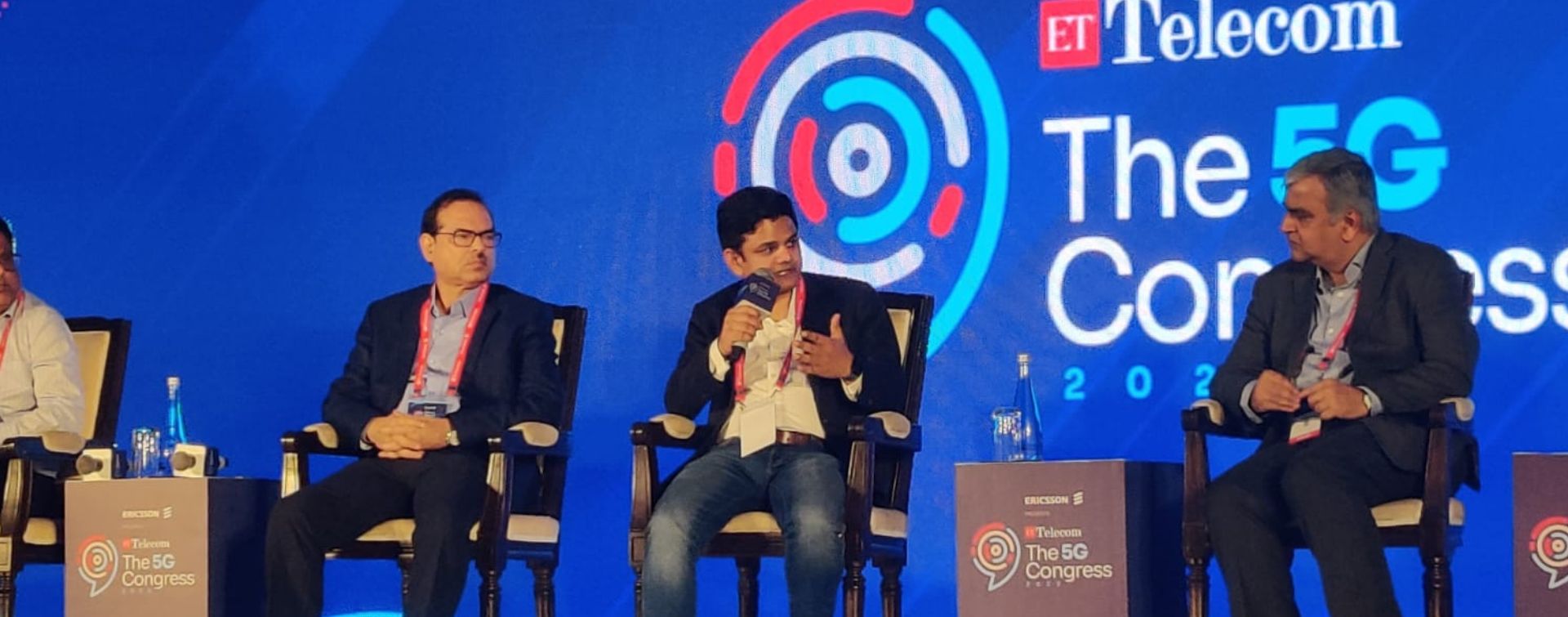Ciena discusses what it will take for 5G rollouts to be successful in India
Ciena's Vikram Anand and Digvijay Sharma recently participated in crucial roadmap discussions for 5G rollout in India at ‘ET Telecom 5G Congress 2023’, held in March 2023 at New Delhi. What is 5G rollout’s success dependent on? What key factors should telcos focus on to make 5G rollout a success in India? How will leveraging automation, virtualization, open networks, network slicing create a profitable 5G business model? Vikram Anand brings holistic insights on these questions. This article was originally published on ET Telecom.
Along with my colleague, Digvijay Sharma, we recently participated in crucial roadmap discussions for 5G in India at ‘ET Telecom 5G Congress 2023’, held on 23rd and 24th March 2023 in New Delhi. The event was inaugurated by the Minister of State (MoS) for Communications, Devusinh Chauhan, along with Chief Guest, Shri K. Rajaraman, Secretary, Department of Telecommunications. With participation of over 400 industry delegates of key telecom stakeholders across India, several pragmatic approaches were discussed on 5G rollout and success for India for current and future scenarios, which will contribute to the vision of Digital Bharat and Make in India. In his inauguration speech , Minister of State (MoS) for Communications, Devusinh Chauhan, said “Globally, 5G is expected to drive a $ 2.2 trillion economy by 2030, and to be part of this growth, we want to make 5G available to every Indian at affordable rates.”
This is a very powerful statement, and in my opinion, an achievable one. I’ll provide my personal thoughts from the event, and how I see 5G in India going forward, but first let’s talk about challenges ahead.
5G rollout: challenges ahead
With fierce competition, surging bandwidth demand, adoption of new technologies, ongoing support for 4G and earlier generations of legacy infrastructure, constrained spectrum availability, delays from clearance of Right of Way (RoW), and operational challenges make creating a profitable 5G business case a monumental challenge faced by telcos.
Additionally, network architecture modelling, how to manage the core network, will software vendors or Service Providers adapt to changing technologies, as well as migration and coexistence between automated systems and legacy infrastructure must be diligently and flexibly addressed. More so, because 5G standards, tools, and architecture continue to evolve, the current choice of solutions deployed by telcos must be future-proofed to maximize investments made today and into the future.
What are telcos looking for?
The most important capabilities of 5G deployments are 1) enhanced Mobile Broadband (eMBB), 2) Ultra-Reliable Low-Latency Communications (URLLC), and 3) massive Machine-Type Communications (mMTC). While eMbBB has more to do with basic and early 5G deployments, the latter two are more complex, application-based capabilities.
Currently, India is in the deployment phase, while simultaneously paving way for use-cases test beds. Upon breakthroughs in fields like healthcare (ex. remote surgery), agriculture (ex. artificial rain induced by networked machines interacting with one another), manufacturing (ex. Industry 4.0 automation), and smart cities, there will be a plethora of business possibilities, which will change the face of humanity.
These exciting possibilities require a winning network rollout strategy, a convergence of legacy and future network architectures, a manager to seamlessly run the network, network security leveraging data-based analytics, agility in adoption of new technologies, and most importantly – the opportunity for 5G monetization – given the high OPEX and CAPEX associated with rolling out 5G. This is exactly what telcos are looking for going forward.
5G can be a success with the right mix of building blocks and strategies to make 5G rollout a commercial success.
Intelligent, data-driven automation and virtualization
While automation is advancing, it is doing so slowly. If you really want to leverage the full benefits of automation, telcos must leverage rich, data-based analytic capabilities sooner rather than later.

During a panel discussion at the event, my colleague, Digvijay Sharma, Senior Director of Sales at Ciena, had some interesting insights with respect to automation and current fiber availability. He mentioned that networks currently on fiber may post complexities for 5G due to the quality and lack of general availability of a reliable fiber plant for mobile backhaul. Unavoidable RoW hurdles result in additional challenges to successful rollouts if the full performance benefits of 5G are to be commercially realized. The second aspect is that 5G requires different Service Level Agreements (SLAs). These are complex challenges, from overall network operation and execution viewpoints. This is where intelligent automation plays a key role.
“The right level of automation increases the speed of rollout and quality of service - making things done right the first time. And in turn, increasing the end user experience. Hence, with the current complexity automation is the key cornerstone to achieve the right speed and with a great user experience,” Digvijay said.
Own the Edge
Telcos must be 5G ready from a from a wireless perspective and edge locations must be closer to end-users, humans, and machines, for optimal compute and storage performance required of URLLC and mMTC applications. Cloud-native applications are trending and require low latency and processing power. As a bare minimum, metro networks must be highly automated and adaptive, along with a strong partnership between Service Providers (SPs) and hyperscalers.
In fact, edge locations are crucial for enterprise 5G services, which are a focus of new revenue streams for MNOs. The current models being explored in this context are 1) Cloud on-ramp, where the service provider pays on-the-go for data migration to the cloud, and 2) Distributed cloud fabric, requiring improved scalability for connectivity between multi-cloud providers.
Data analytics
Streaming-based data analytics add value when real-time network parameters can be measured, along with Key Performance Indicators (KPIs), to best yield actionable business outcomes. Again, intelligent automation plays a crucial role here in securely reporting and analyzing real-time streaming data from a highly instrumented network.
5G monetization
The 5G business model success will rely on delivering an immersive, high Quality of Experience (QoE) to end users. This implies a need for de-siloed, high-quality xHaul (fronthaul, midhaul, backhaul) transport links, end-to-end Software-Defined Networks (SDN), Open RAN (O-RAN), and multi-vendor ultra-dense, multi-layered networks along with local manufacturing. These factors will help SPs monetize and future-proof their substantial and ongoing 5G investments, which brings us to our next point – choosing the right partner in your 5G journey who is more than just an equipment supplier.
The right partner
The need for a partner vendor ecosystem which understands your unique 5G journey, current network architectural challenges and works with you on making the best decision for you, is required to create a successful 5G business case for you and your customers. Be it hyperscalers, equipment vendors, application software vendors and system integration partners, industry expertise and field-proven experience is critical.
In fact, this becomes even more critical for enterprises, both large as well as small and medium. Small and medium enterprises are looking for telco partners willing to offer cloud and connectivity-based services and are open to adopting 5G because they see value coming from data analytics, where KPIs can be measured for successful business outcomes.
Most enterprises want to focus on their core business and want service providers offering consumption-based models based on business outcomes, which also creates an opportunity for them to become more relevant to their end customers.
To sum it up, I will say that while 5G is here, and the factors mentioned above are being adopted, we are still moving at a slow pace, considering emerging customer demands. A carefully crafted 5G network rollout and associated commercialization strategy, based on your unique KPIs, pave the way in making 5G a business outcome gamechanger.











